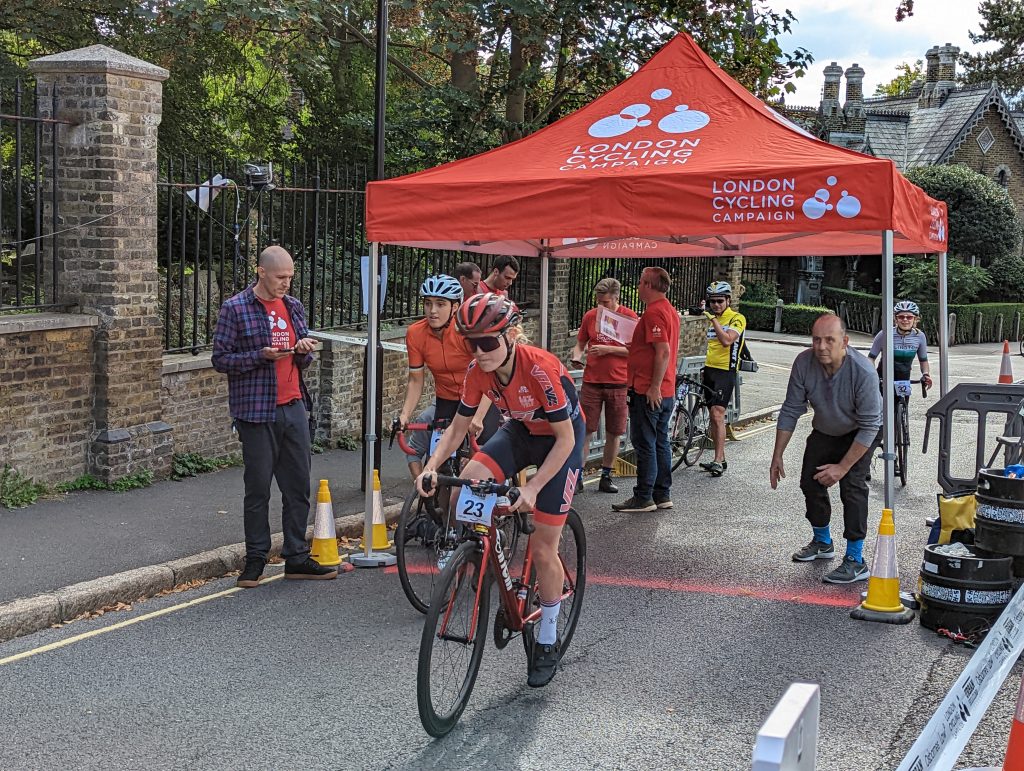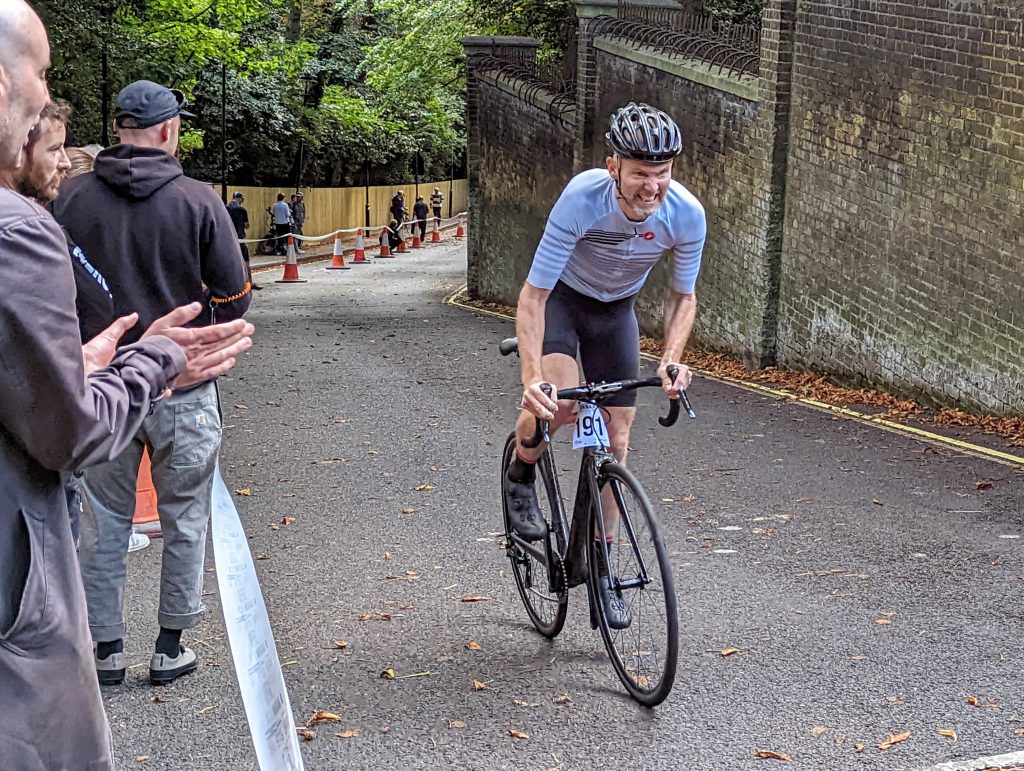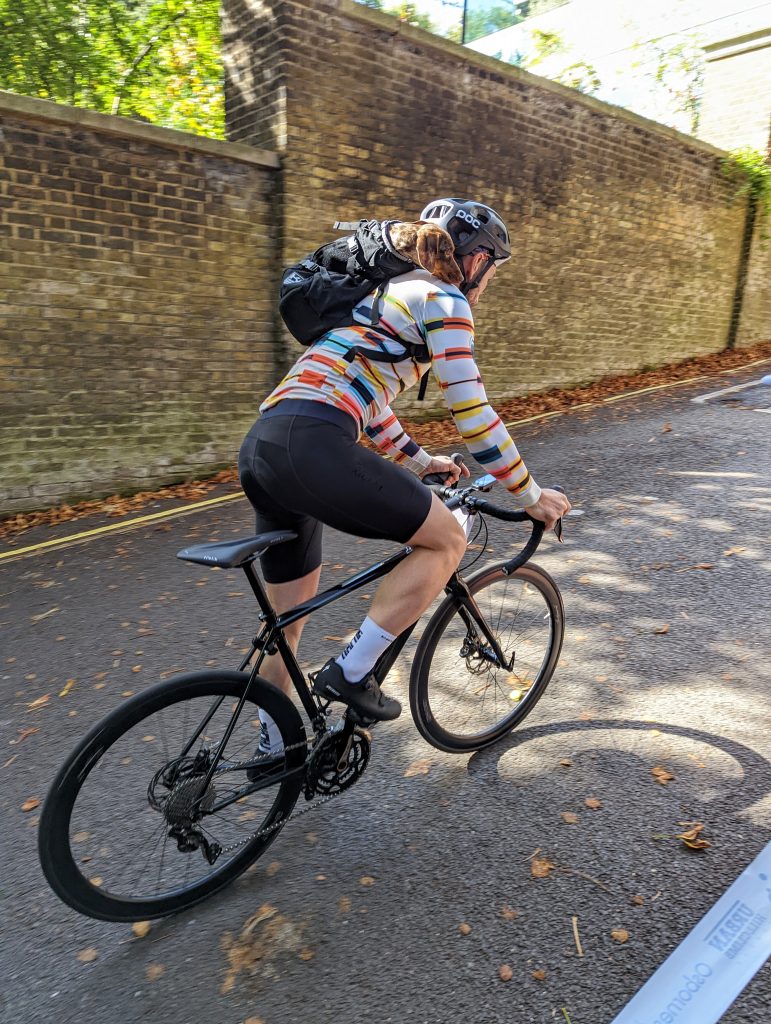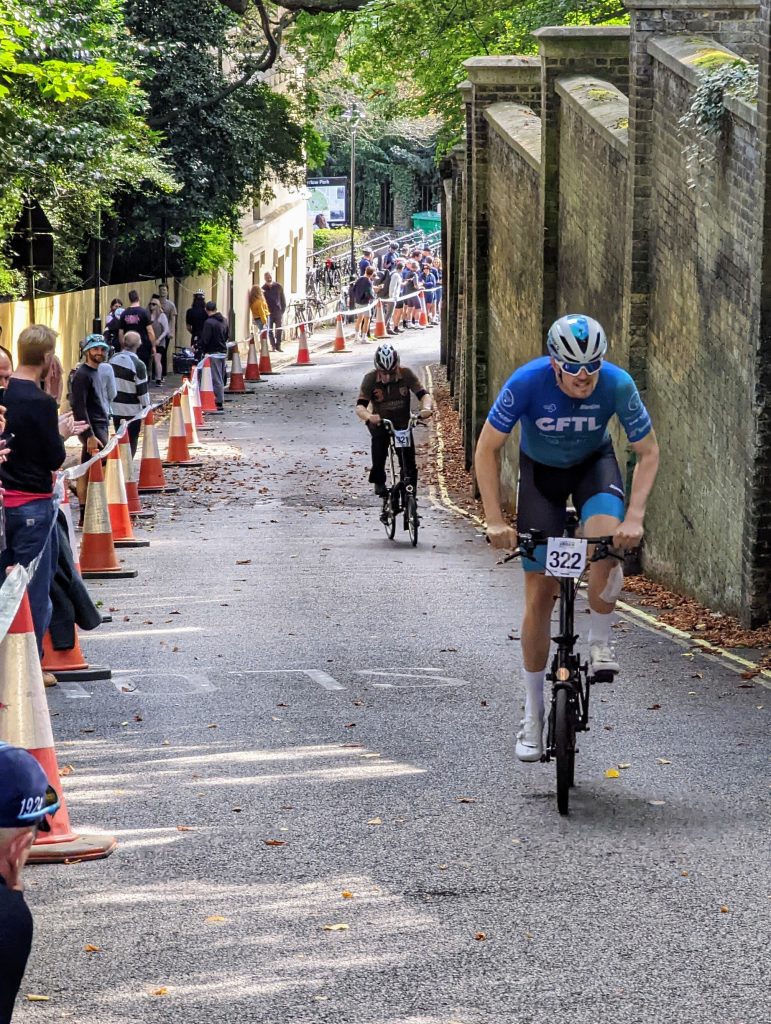The UK has some very individual events in the world of cycling – a good example being the classic 10 mile time trial, often take place on stretches of dual carriageway. And then there are the hill climbs. These events tend to take place in the early autumn, organised by local clubs, and involve riders setting off individually against the clock on some notorious local climb.
The specialists in this world have very high watts per kilo figures – that is, they tend to be quite light, but able to put out immense amounts of power, at least for the few minutes that are required to tackle the hill.
Then there are the bikes. In mainstream professional cycling, the governing body, the UCI, sets a minimum weight of 6.8kg for any bike. Many cycling companies could make a bike lighter than this, but there’s a safety element to it, the thinking being that if a bike is too light, it may be more susceptible to manufacturing problems.
But in hill climbs, the UCI rules don’t apply. The organisers tend to insist on you having at least one front brake – you’re travelling uphill after all. And you obviously have to wear a helmet. But beyond that, it’s up to you. Pick the lightest materials known to man and minimise them. In the old days of steel bikes, competitors would take drills to some parts of their bikes, cutting holes in steel where they felt there was “excess” material serving no good purpose. Even today, it’s pretty common for riders to saw off the “drops” of their handlebars – the curved bits at the bottom. Since you’re riding uphill on the “hoods”, quite frequently out of the saddle, there’s no real purpose for the drops which are more useful for getting low and aerodynamic, particularly when going downhill or in sprints. So off they come.
That gives you a flavour of the scene, one that I’d read about but never contemplated before. While I think I’m OK at climbing these days, I’m not superlight by cycling standards, and even my carbon Canyon bike is nowhere near as light as many bikes out there, being about 1.4kg over the UCI’s minimum weight.
So what on earth made me enter the Urban Hill Climb organised by the London Cycling Campaign?
Well it seemed like fun. Also, they were selling a smart new “London” cycling jersey available, at least initially, to entrants.
The Urban Hill Climb hasn’t taken place for the last couple of years, for obvious reasons, but it was back this year in its usual venue on Swain’s Lane.
For those who aren’t especially familiar with the geography of North London, Swain’s Lane is a hill that runs between the eastern and western sides of Highgate Cemetery which has many famous figures buried in it, perhaps most notably, Karl Marx.
Highgate itself sits on a hill over London, and there are various routes up to it. Swain’s Lane is not the most obvious route to use and indeed aside from visitors to the cemetery, it’s probably mostly used by locals or as a bit of a rat-run if the main routes are a bit traffic-clogged.
I’ve been cycling to and from work every day since returning to the office post-pandemic, and I have two main routes. One takes me along Green Lanes, around to Finsbury Park and then past Arsenal’s stadium and through back streets to the West End. The other, slightly hillier route, runs through back streets, around Broomfield Park, through the edge of Alexandra Palace park, through Crouch End, up past the Whittingdon Hospital, through Camden and then alongside Regent’s Park.
On the way home, this second route includes a steep climb up Dartmouth Park Hill close to the hospital. Despite having ridden this route dozens of times, I’d never actually explored the parallel road to this, the other side of the eastern part of the cemetery – Swain’s Lane.
That is, I hadn’t until August when I entered the Urban Hill Climb. “I should probably check out the climb,” I thought to myself. And so, on a nice August evening, I returned home that way, with a laptop-filled backpack on my back, to tackle the climb.
The lane starts at a fairly modest 6% or so, and you feel that you can ride it OK, perhaps even with some speed, but the gradient continues to kick up to 8% and then 9%. Looking ahead, you can see the entrance to the cemetery on the left-hand side of the road, with a gate to the other half of it on the right. Is the climb over?
No it’s not.
But at that point the road goes around a walled corner and you can’t see what awaits you.
What does await you is the steep section. The road suddenly pitches up to 11%, then 12% and finally more than 13%. Looking around the internet, there are claims that it reaches 20% and I’m not sure that can really be the case. On the other hand, it does feel like more than 13% too – although the reliable Veloviewer says that the maximum gradient is 13.2%.
Whatever the gradient, the road narrows and it’s now much harder. If you thought you were already at the top, you were wrong. Trees overhang the road on the right, while there’s a tall wall on the left, at least until you come to a couple of very “Grand Design”-type homes along that wall.
With your lungs bursting and your legs sore, the road begins to flatten off a little, but you’re still rising as you reach a broadcast mast on the right dominating the skyline (previously used for TV broadcasts, it’s mostly used as a communications tower and for mobile phone coverage these days).
All the way up, you’ve also had to navigate speed bumps, and now the road narrows through a gap also designed to keep traffic from speeding up a road that until this point has been one-way. Passing a small right-hand turning, you finally emerge at a T-junction. You’re at the top.
For the Urban Hill Climb, the start point is parallel with the southern-most tip of the cemetery, while the finish is at the traffic narrowing point towards the top.
Back in August, I didn’t know all of this and hit the hill hard, only realising as I rounded the corner past the cemetery entrance that I was in for some pain. But seeing some other cyclists going slower than me was the driver that pushed me on and while I wasn’t “troubling the scorers” Strava told me I’d done OK on the segment. For the part of the climb that would be included in the Urban Hill Climb, I’d set a time of 2:33. This, with a backpack and on my, still-quite-decent, commuter bike.
Over the next few weeks, I included the climb as many times as I could on the way home, looking to go faster.
And I didn’t go any faster.
Somehow, knowing the hill as I now did, I couldn’t get my speed up. The best I managed was to get within 4 seconds of that first ascent.
Still, at least I wouldn’t have a backpack on when I hit the hill for real. And I’d be using a better, lighter, faster bike!
The Urban Hill Climb event is divided into lots of categories, and I was in the 50-59 year old male class. We were setting off early-ish, although after the youths and juniors. I arrived about an hour early as requested to register and get my number and timing chip. Then I went down to see the youngsters compete.
The fastest under-16 boy did the climb in 1:42!
Right.
Now of course, those kids would be a lot lighter than me, and some of them would have very smart bikes. I know this is the case because one of the starters commented to one lad on his hub that must have cost “thousands.” But still…

I climbed the hill to watch more of the action.
The event sees riders go off separately at 30 second intervals. Even though the route is only 700m long, the varying skill levels mean that sometimes a rider will overtake the rider that went off 30 seconds before them. That’s especially the case when the organisers don’t really know anyone’s skill levels (I suspect they do know the superstars of the scene and set them off closely together).

Soon it was time for me to go. I did a bit of warming up and was prevaricating over which chainring to use. I don’t tend to ride at a high pedal speed, cadence in cycling terminology, preferring to push more power through a lower cadence. And nearly every time I rode this hill on the way home, I did so in the big chainring. That’s not to say that I didn’t go through my gears on the chainring on the back wheel as I climbed.
I was looking at some of the riders, and they varied in what they were doing. In the end, I stuck with what I new, although I ended up dropping through the gears when I went up.
I was riding in clipless shoes, and a worry of mine had been that I would lose time “clipping in” when I started since the hill goes straight up, which can cause problems. Even professional cyclists can be a bit slow clipping into their pedals – with most road races having rolling starts minimising this as an issue. Fortunately the starters were offering to support your bike so you could be fully clipped in when you began. This was slightly unnerving as you had to put your trust totally in a stranger to keep you upright. When you’re clipped in and stationary, that usually only means one thing. You’re going to fall over on your side.
The people ahead of me had started and now it was my turn. I got a ten second countdown, and then I was away. Instantly my gears slipped and there was a crunch as the chain found a happy compromise.
I panicked a bit, and instantly got out of the saddle to make up time. In truth, I’d probably lost at most a couple of seconds. But I wanted to put a respectable time in.
Adrenalin coursed through me, and I powered up those early 6% and 7% slopes, suddenly arriving at the cemetery entrance where the course announcer was stationed. I heard him mention my name, and appreciative spectators at the side of the road rang cowbells – the small kind that the LCC were handing out.
I stomped on the pedals, but realised I’d gone out too fast and couldn’t maintain this momentum up the steep section. Ahead of me, a photographer was stationed at the very steepest bit of the course. But I was slowing even as the thicker crowd up here cheered me on.
I also realised that I’d been out of the saddle too much and suddenly couldn’t stay out of the saddle the whole way. Getting back into the saddle meant using a smaller gear.
I was slowing.
I could see the digital clock ahead of me where the finish was, and I knew the road was now getting easier, but I was drained.
But I pushed through, gritted my teeth and before I knew it, I’d finished.
Beyond the finish line, riders were scattered around leaning on their bikes, sitting on the curb and generally gulping air like it was going out of fashion.
To one side of the road cans of still water were being handed out. I grabbed one and downed it pretty quickly. While I hadn’t done anything much to lessen the weight of my bike, I’d not brought a drink and definitely wasn’t carrying an even partly-full bidon up the hill!
I’d also left my saddlebag at home, and gone without anything more than the bare minimum I needed – by phone, my keys and my bike computer – although even that was in truth, an unnecessary weight. A marshal joked that I had left my bottle cages on my bike, and my bar tape. Between them, these would only add a tiny amount of weight to my bike. The hill time specialists remove absolutely everything that can save them a few grams.
I got my breath back and spoke to a guy I’d met at the bottom the hill who went up just ahead of me. He told me that he’d done it in 2:20 which sounded good to me. I didn’t know my time, and in any case, my early over-exuberance probably meant I didn’t have that fast a time. I wasn’t even sure that I’d beaten my commute-home time set back in August.
I’d been one of the last few in my age group to go off, so by the time I looked at the online results, which it turned out were going up very efficiently and near-instantaneously on their website, I could see that I was in fact 6th out of the 42 starters in my age group.
Wow.
My time was 2:06 – much faster than my previous 2:33 record – and in fact, only six seconds off third place on the “podium.” (I put that in quotes, but they did have an actual podium!)
Whether I could have made up those six seconds with a better timed run, I don’t know, but I definitely felt I could have gone better.
And to be completely clear, while 2:00 was the time for the third placed 50-59 Man, the fastest chap did it 1:43, and I know I couldn’t make up 23 seconds!
Anyway, I was enormously satisfied my 6th place.
I’d had thoughts that perhaps someone from behind me might pass me. And while I knew I could easily get up the hill – I wasn’t sure how fast I could really do it.
I walked down the hill and treated myself to a beer from the Howling Hops Brewery’s stand – they have very smartly designed cans, and I enjoyed one of the Hackney Wick-based company’s pale ales while I watched others endure their minutes of pain, cheering them on from the roadside.




While I took the hill climb fairly seriously, not everyone did; or at least, they weren’t out to “set a time.”
Franklin the mini dachshund was getting a lift with his owner Martin.

While the even more Instagram-famous Sigrid was getting a lift with Travis who had boldly decided to attempt the hill climb on a singlespeed!

Sigrid seemed to be suitably non-plussed by the whole thing.

The event has categories for folding bikes and cargo bikes. The latter included e-assist bikes as well as fully manual ones. The only key thing criteria was that if you were riding a cargo bike, there had to be some actual cargo. That tended to be a barrel of beer, passengers, or even multiple passengers!




I didn’t stay right until the end, as traveling light meant I had no jacket or other clothing to put on after my ride. So I missed the very fastest riders towards the end of afternoon, with Henry MacFarlane just pipping Calum Brown by one second to get the overall fastest time of 1:22. However Brown beat MacFarlane in the head-to-head final, where the slower times suggest tactics came into play. Leonie Harper was the fastest women in a time of 1:45, and was only 3 seconds slower in her final that she comfortably won.
But I had great fun overall. It was really well organised and marshalled, and everyone seemed to be enjoying the day.
I definitely plan to be back next year.



Comments
2 responses to “Urban Hill Climb 2022”
Nice write-up. It was also my first hill-climb event and I thoroughly enjoyed it. I can only hope I can one day cycle up that hill as quickly as you did 🙂
On the point of regulations, as I understand it, the rules for hill climbing (Time Trialling, really) were recently updated and they now require two brakes that “must operate independently on both front and rear wheels”. Apparently a front light is also mandatory.
That said, I’m don’t think Urban Hill Climb is governed by CTT regulations, as I believe it’s not an event on the race calendar, since you can take part without having a racing licence, and the Rider Briefing stipulates bikes must be “road legal”.
Hi Niklas,
Thanks for the kind words!
And thanks for the clarification on hill climbing rules. I’m certainly not an expert on them.